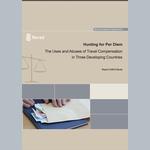De brune konvoluttene. Misbruk av bistandsmidler?
<div class="event-icon"></div> <span>Save this event in my Outlook calendar</span>
<div class="event-icon"></div> <span>Save this event in my Google Calendar</span>
Lansering av rapporten "Hunting for Per Diem: The Uses and Abuses of Travel Compensation in Three Developing Countries".
Eirik Gjøstein Jansen, seniorrådgiver i Evalueringsavdelingen ved NORAD
Svend T. Skjønsberg, Riksrevisjonen
Tina Søreide, seniorforsker ved CMI
Arne Tostensen,seniorforsker ved CMI
Møteleder: Christina Pletten, journalist i Bergens Tidende
The need to improve quality and efficiency in most developing countries’ basic service delivery explains why a significant proportion of aid is spent on seminars, workshops and travel arrangements for civil servants and staff of non-governmental organizations (NGO).
Various forms of per diem (non-salary daily subsistence allowance) are intended to compensate employees of public and private organisations for extra expenses incurred when on work-related assignments away from their normal duty station or home base. The compensation offered is normally set at standardised rates, payable according to stipulated rules and regulations. Per diems may function well and cost-effectively in most settings. However, there is often a discrepancy between the standardised rates and the actual costs. This makes per diems susceptible to abuse. The large amounts spent on per diems every year, signals that the system needs to be revised.
In the research project “Hunting for Per Diems. The Uses and Abuses of Travel Compensation in Three Developing Countries”, Tina Søreide and Arne Tostensen, senior researchers at the Chr. Michelsen Institute, and Ingvild Aagedal Skage, PhD student at the Faculty of Comparative Politics, UiB, have enquired into the laissez-faire culture of per diems in Tanzania, Malawi and Ethiopia.
Publication

Hunting for Per Diem: The Uses and Abuses of Travel Compensation in Three Developing Countries
Project

